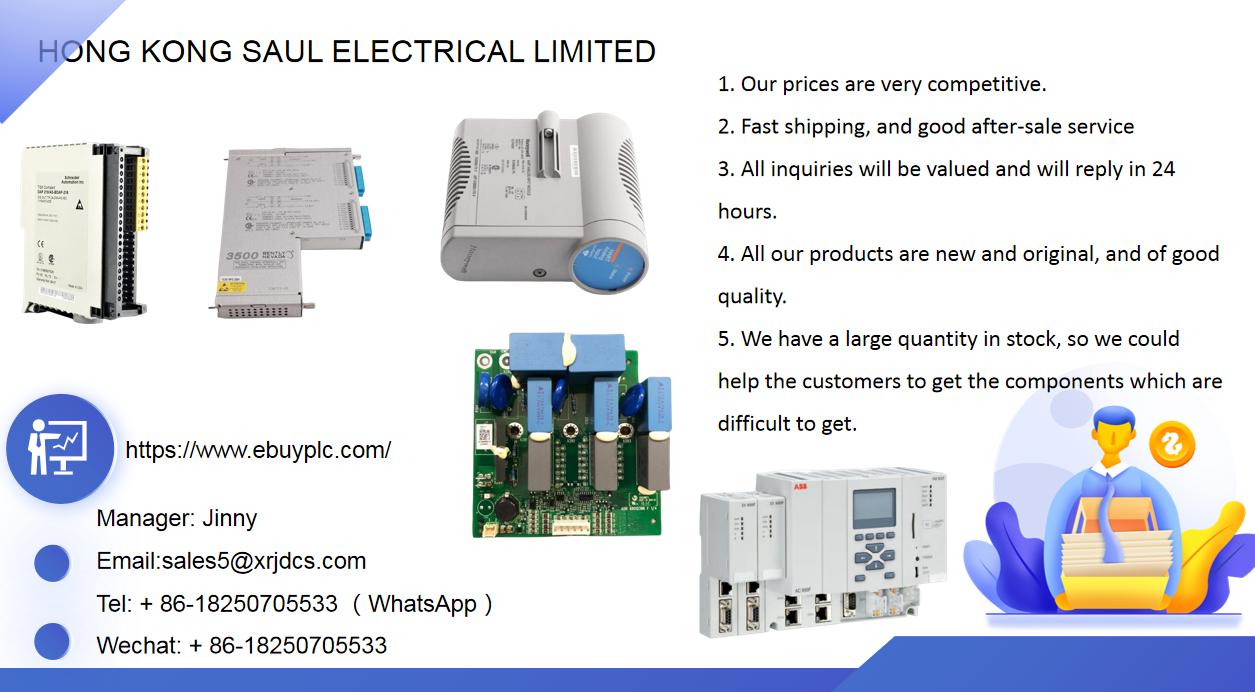0102030405
DCS system commissioning scheme
2023-12-08
The on-site commissioning work is mainly to check the system software used, and to confirm the configuration and function test of the application software.
1. Inspection before power on
The cable insulation resistance meets the requirements (more than 5M Ω). Check the cable insulation resistance test record, and conduct spot check and measurement if necessary.
Check that all power lines, signal lines and communication buses are connected correctly.
The models and positions of the cards, adapters and their interfaces in the control station, console, engineer station and other machine racks are correct.
The preset knob position of each card is correct.
The power switch on the power supply unit and the card is in the "OFF" position, and all fuses are intact.
All connecting screws in the cabinet shall be firm without looseness.
Grounding resistance test of grounding system:
L Remove the "MG" and "CG" grounding buses from the ground plate of the control room, and measure the base grounding resistance with the grounding resistance tester, which shall meet the design requirements (less than 10 Ω).
L Use a multimeter to check whether the grounding busbar of each cabinet is connected with the "MG" and "CG" grounding plates respectively.
L The measured insulation resistance between "MG" and "CG" shall meet the requirements of GBJ93-86 (greater than 5M Ω).
UPS power supply test:
L Check that both the power panel and the power switch are in the "OFF" position.
L The electrical personnel shall put the UPS into operation and measure the voltage before sending it to the main power switch of the instrument power panel to be 220VAC ± 10%, 50Hz ± 2%.
L Electrical personnel shall conduct UPS continuous test. (After the full load is put into use, repeat the test, and the battery power supply time shall not be less than 30 minutes)
2. Power on test
Carry out the following power on tests on each cabinet and console one by one:
L Place the power switch to the cabinet in the power panel at the "ON" position and check the voltage in front of the cabinet main power switch with a digital multimeter, which should be 220 ± 22VAC.
L Confirm that all cards in the cabinet (except the power card) have been unplugged from the card holder, then turn the main power switch, power unit and power switch on the power card to "ON" in turn, and measure the DC voltage output with a digital voltmeter, which should meet the requirements of the manufacturer's instructions (5.1 ± 0.02V, - 12 ± 0.3V, 12 ± 0.3V, 24 VDC). If it exceeds the allowable deviation range, adjust it.
L Conduct manual switching test of dual power supply.
L Power on all nested fans, signal converter fans, hard disk drive fans, cabinet top fans, door fans, etc. Check that all fans operate normally.
L Check whether the power alarm circuit works.
3. System startup and loading
L Engineer station startup procedure.
L Operation station startup procedure.
L Control station startup: after power on, call out the system status screen, and confirm that the status is normal.
L Loading operation.
See the instructions for loading procedures of each station.
4. System diagnosis and redundancy test
① Call up the system diagnosis screen and carry out diagnosis and inspection for each station and station.
② For various redundant modules of the system, artificially simulate the failure (by cutting off the power supply, unplugging the power plug, inserting the card, etc.), observe whether the standby module can operate within the specified time, observe the switching process on the console, and observe whether the automatic switching process is normal.
L Communication redundancy test
L Redundancy test of dual controller
L Redundancy test of operation station
L Printer hot standby test
5. Picture test
1) Flow chart screen test:
a) The process screen shall be displayed in the form of P&I diagram, and the number of pages and screen contents shall meet the configuration requirements.
b) Static display inspection of the screen:
*Check the position, color and text description of the title.
*The shape, size, position and color of the graph.
*Width, position, color and inlet and outlet joints of process pipeline.
*The symbol, text, size, position and color of the measured variable.
*Arrow, width, position and content of instrument signal.
*The shape, size, position, color, and arrow of the page connection symbol.
*The engineering measurement unit shall meet the design requirements.
c) Dynamic display inspection of the picture:
*The variation value of the measured variable shall be within the precision range that can be identified by the system.
*Color change of valve and pump operation status.
*The alarm status changes and should be the correct priority.
d) Select the loop from the flow screen to adjust the set value, control mode (automatic/manual) and manual output.
2) General picture test
a) Confirm that the overview screen has been configured according to the configuration data table.
b) Check the correct configuration of groups and units in each area of the general picture.
3) Group picture debugging
a) Confirm that the loop in the group screen is consistent with the group described in the general picture.
b) All measured values, set values, analog and digital outputs are correctly configured.
c) Conduct the test of changing the set value, control mode and output.
d) For the group picture of digital or program circuit, the color of the observation block or the change of the status display information shall meet the configuration requirements by changing its status.
e) Confirm the configuration of selectable functions: high-low limit alarm, deviation alarm, output limit, adjusting parameters, power failure restart mode, cascade or feedforward loop information, filter parameters and other information related to the loop or digital program.
6. Function test of operating keyboard
1) Confirm that the function keys directly operated by the operator operate normally, call out various displays, operate each circuit (including control mode, set value, set cascade, output signal adjustment, etc.), alarm confirmation, and execute various functions of the printer.
2) Confirm that the operator keyboard function started by key lock or password operates normally, and can change the measurement range, alarm value, output signal limit, etc.
7. Report test for printer and copying machine
1) Check that the printer can print the information specified by the operation station.
2) Confirm that alarm printing occurs automatically, and the sequence is consistent with the alarm summary screen.
3) Check that the printing of "confirm" or "restore" time is the same as the actual occurrence time.
4) Check that if the number of alarms is faster than the printing speed, the alarm printing will not be lost.
5) Check that if the printer fails, the alarm points within this period can still be printed correctly after repair.
6) Confirm that the interlocking alarm from PLC has the first signal display in the specified group (the whole interlocking is divided into groups), and has a resolution of 300ms.
7) Confirm that the copying function can hard copy any picture displayed on each CRT screen, and at least one picture shall be copied for each CRT during the test.
8) Confirm that the report can be printed in the configured format.
9) Check the automatic printing function of hour report, shift report, daily report and monthly report.
10) Check that the report data can be instantaneous value, average value and cumulative value of the first 30 hours (including hourly average value)
8. System recorder test
Confirm that the recorder has been programmed and its functions meet the design requirements.
Add at least one input signal to each recorder (3 records) to check whether it can be recorded by the configured channel.
9. DCS channel test
After the above DCS configuration and function test, 100% channel test shall be carried out, that is, add signals from the I/O input end, observe the indicated value on the CRT of the operation station, output signals from the operation station, and measure the output value at the I/O output end. The deviation shall meet the accuracy requirements (Class 0.2).
Test method: according to the circuit diagram, the input and output signals are grouped and debugged according to analog quantity, digital quantity, thermocouple, thermal resistance and other types.
During commissioning, pay attention to the simultaneous test of circuit branches, indications, records, alarms, etc.
After each loop (or part of it) is debugged, mark the loop with a color pen and fill in the debugging record in time.
Test on sequence and interlocking circuit: check the sequence and interlocking action according to the logic diagram and input signal to ensure they meet the design requirements. If not, check the sequence table configuration.









